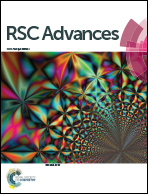Fabrication of polyoxometalate-modified palladium–nickel/reduced graphene oxide alloy catalysts for enhanced oxygen reduction reaction activity
Abstract
Designing advanced nanocatalysts for effectively catalyzing the oxygen reduction reaction (ORR) is of great importance for practical applications of direct methanol fuel cells (DMFCs). In this work, the reduced graphene oxide (rGO)-supported palladium–nickel (Pd–Ni/rGO) alloy modified by the novel polyoxometalate (POM) with Keggin structure (Pd–Ni/rGO-POM) is efficiently fabricated via an impregnation technique. The physical characterizations such as X-ray diffraction (XRD), Fourier transform infrared spectroscopy (FT-IR), Raman spectroscopy, inductively coupled plasma optical emission spectroscopy (ICP-OES), field emission scanning electron microscopy coupled with energy dispersive X-ray spectroscopy (FESEM-EDX), and transmission electron microscopy (TEM) are utilized to confirm the structure, morphology, and chemical composition of the fabricated samples. The XRD results verify the formation of the POM-modified Pd8Ni2/rGO alloy electro-catalyst with the face-centered-cubic (fcc) structure and average crystallite size of 5.54 nm. The electro-catalytic activities of the nanocatalysts towards ORR in alkaline conditions are evaluated by cyclic voltammetry (CV), rotating disk electrode (RDE), and chronoamperometry (CA) analyses. The synthesized Pd8Ni2/rGO-POM nanomaterial shows remarkably greater ORR catalytic activity and better methanol resistance compared with the Pd8Ni2/rGO and Pd/rGO electro-catalysts. The promoted ORR activity of the Pd8Ni2/rGO-POM sample is attributed to the alloying of Pd and Ni components, the uniform scattering of Pd–Ni nanoparticles on rGO, and the alloyed catalyst being modified with POM. Moreover, these findings demonstrate that the resultant Pd8Ni2/rGO-POM material is attractive as a suitable and cost-effective cathodic catalyst for DMFCs, in which the decorated POMs play a vital role for the enhancement in the catalytic abilities of the nanocatalyst.



 Please wait while we load your content...
Please wait while we load your content...